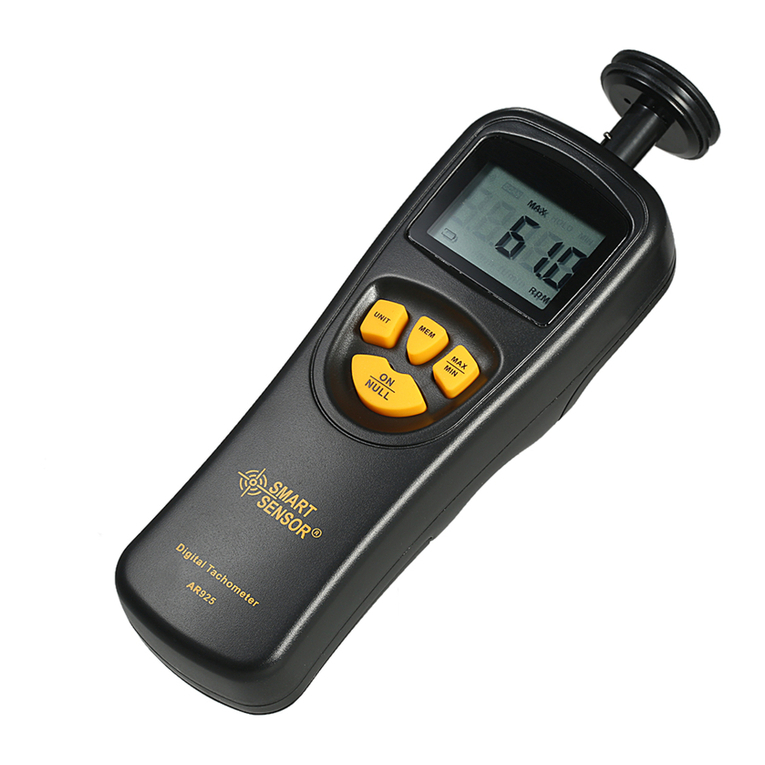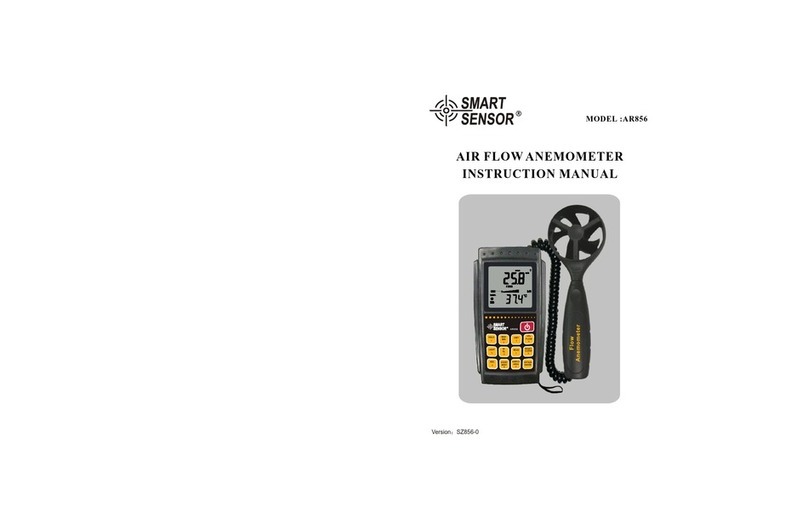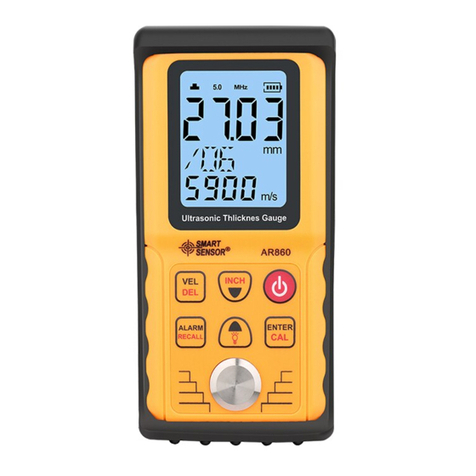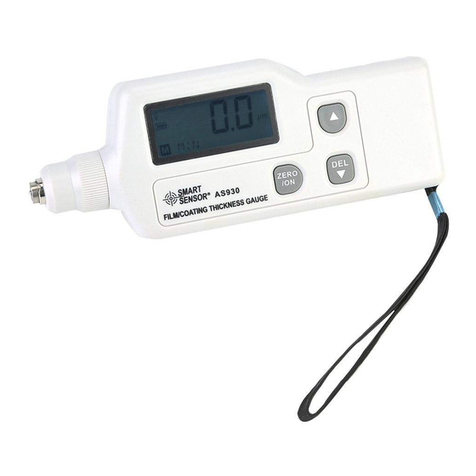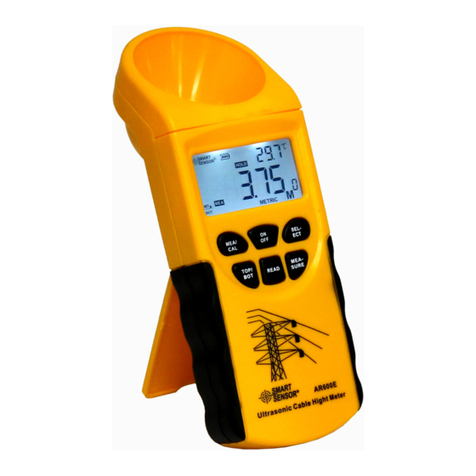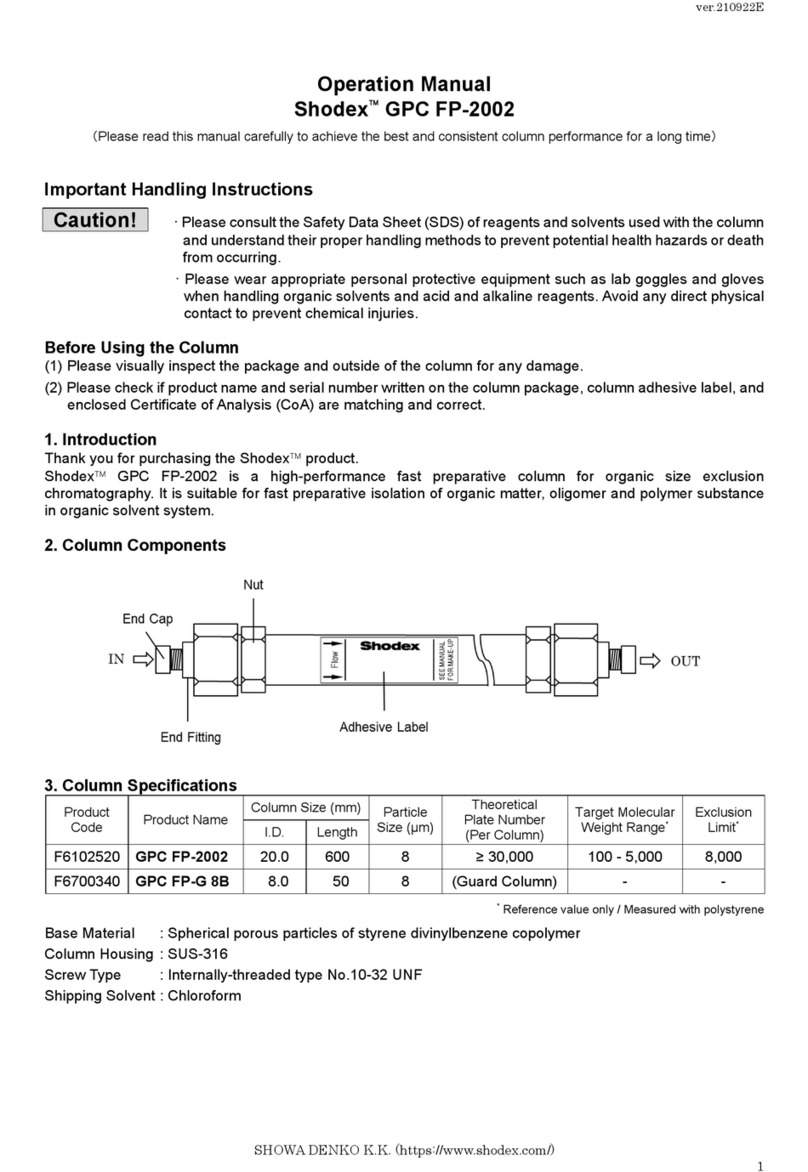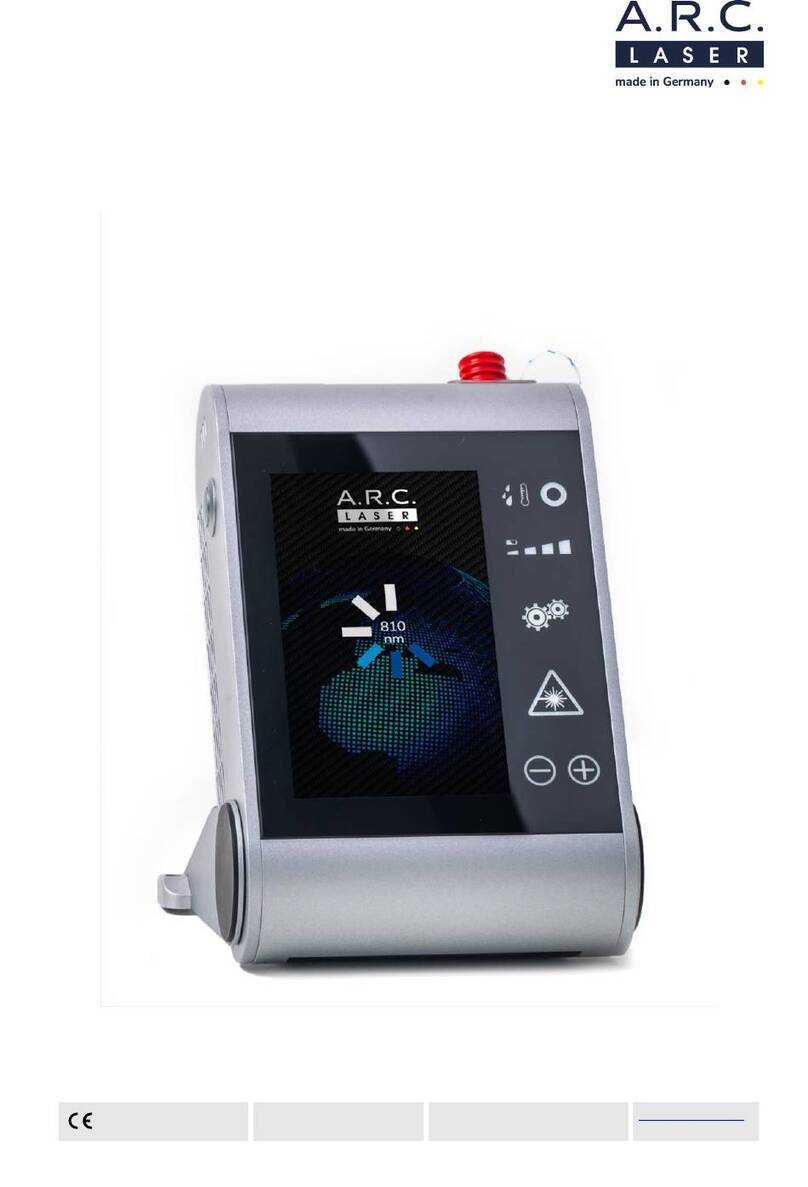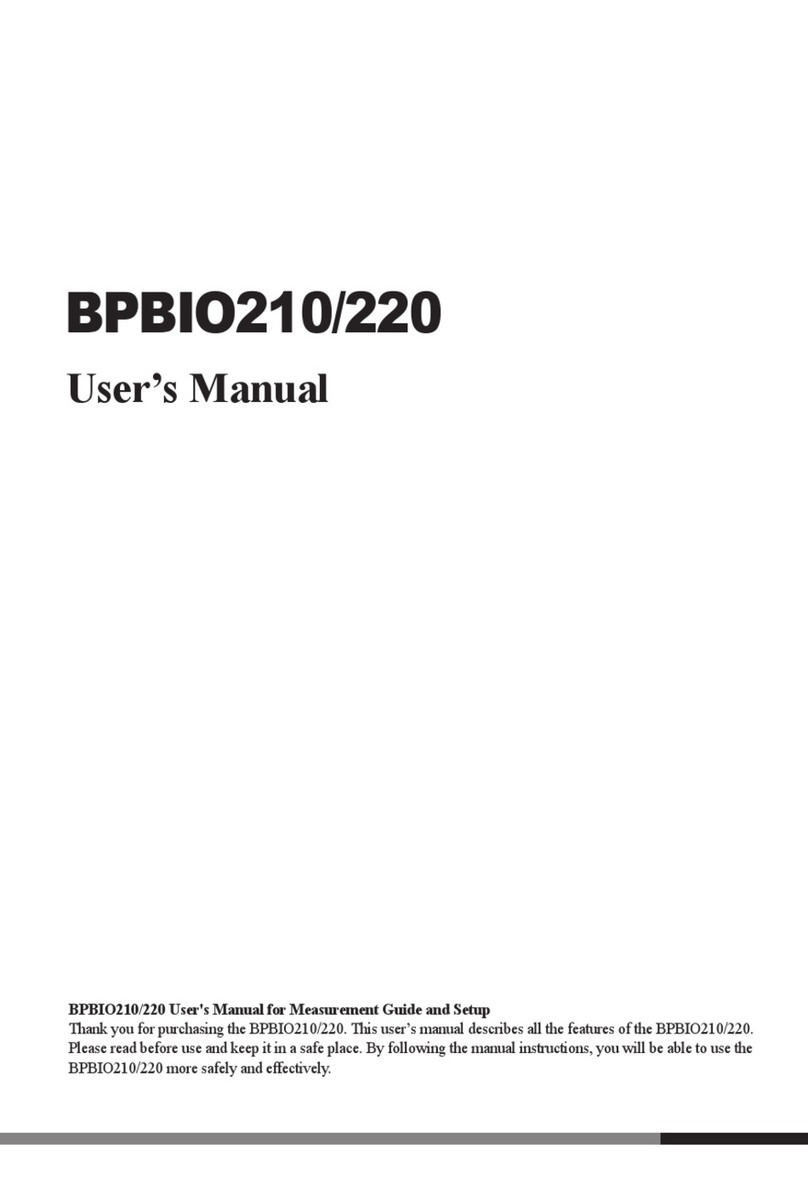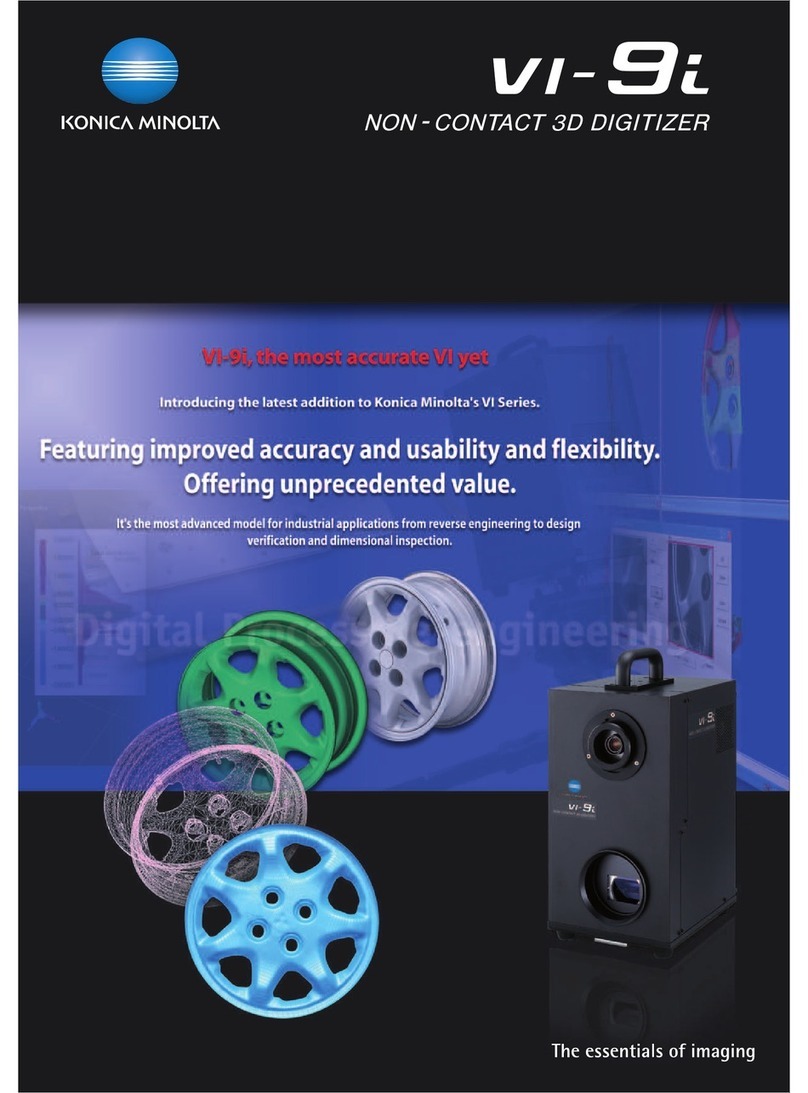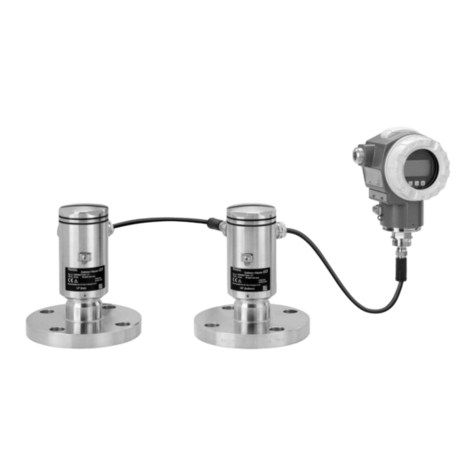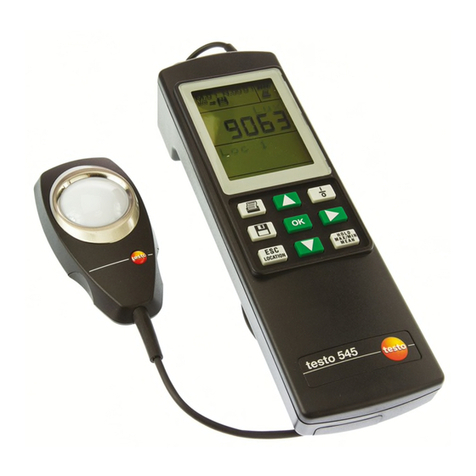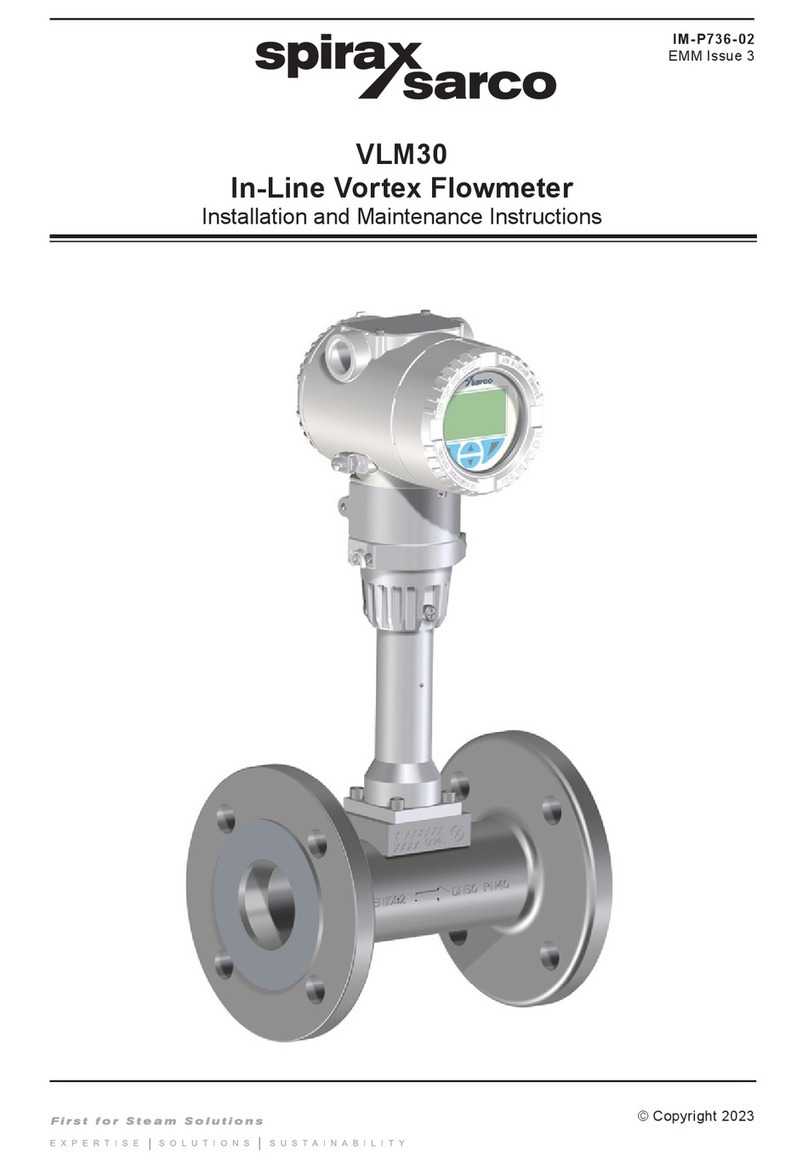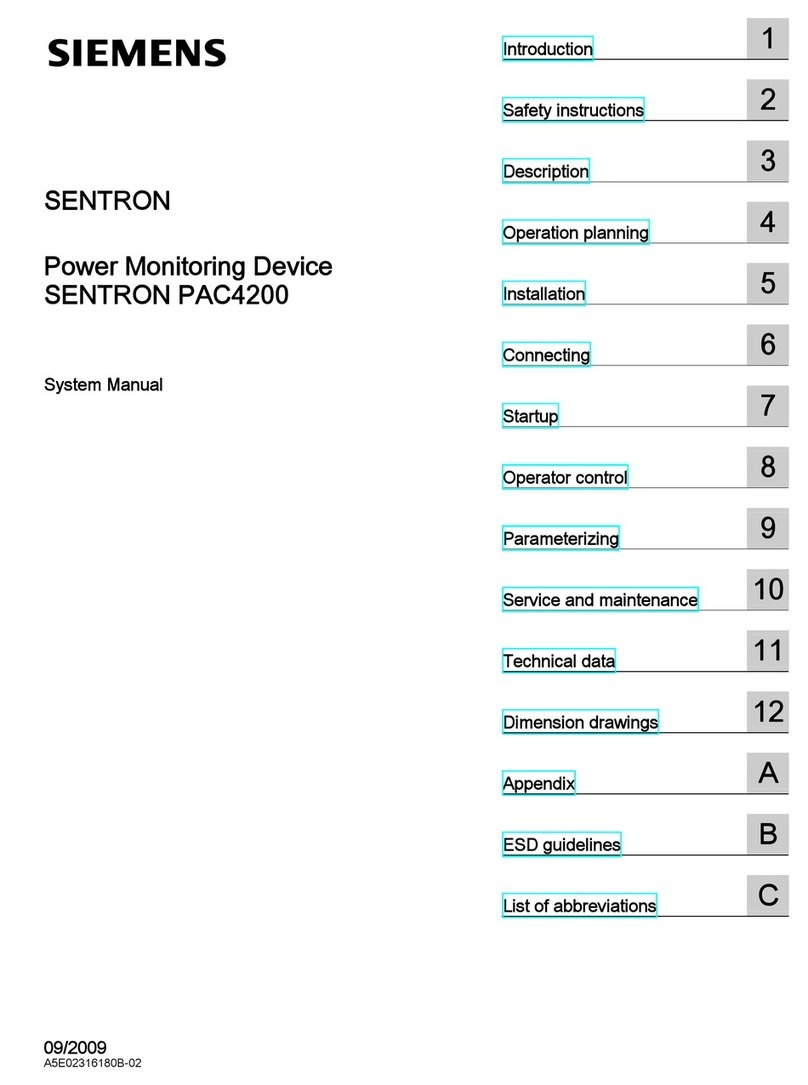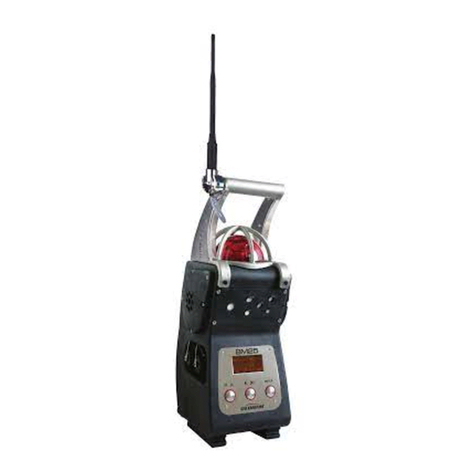Smart Sensor Model AS850 User manual

Ultrasonic Thickness Gauge
Instruction Manual
Model:AS850


1. Introduction----------------------------(01)
2. Operation instruction-----------------(04)
3. Operations procedure----------------(05)
4. Measurement tips --------------------(09)
5. Precautions for accurcy -------------(11)
6. Maintenance---------------------------(13)
7. Notice -----------------------------------(14)
8. Table of sound velocity---------------(15)
Table of Contents
Over warranty period, any repairing / maintenance will charge the fee
on the buyer in standard rate by local distributor.
The standard rate is not including the accessories which not packing
in standard package(For example, abnormity transducer, lengthen
lead-wire, special software) .
We disclaims any liability due to: transportation damages; incorrect
use or operation; manipulation, alterations or repair attempts; without
warranty card, invioce.
7.2. Non-warranty list
LCD, battery, probe, sample block, plastic case, coupling agent
8. Table of sound velocity
Sound velocities of common materials
Aluminum
Zinc
Silver
Glod
Tin
Iron/Steel
Brass
Copper
SUS
Acrylic resin
Water(20℃ )
Glycerinl
soluble glass
2670
3530
4430
5440
5720
6310
6020
5630
5850
5660
6070
4650
2620
Acetate resin
Phosphor bronze
Turpentine
Glass
Incoloy alloy
Magnesium
Monel alloy
Nickle
Steel 4330(mild)
Steel 330
Titanium
Zirconium
Nylon
6320
4170
3600
3240
3230
5900
4640
4700
5790
2730
1480
1920
2350
Material Velocity(m/s)
-15-
Material Velocity(m/s)

1.Introduction
Smart sensor AR850 ultrasonic thickness gauge is an intelligent hand-
hold product, which adopts ultrasonic measuring principle, and is
controlled by micro processor, provides quick and precise measurem-
ent of thickness for most of industrial material. This unit is widely used
in various precise measurement for different hardware / parts in indus-
trial realm; one of its important application is to monitor the level of thi-
ckness-decreasing during operation of various and pressure container.
Diffusely applied in manufacture fields, metal processing, and comme-
rcial inspection. The material that conduct and reflect constant sonic
velocity, this product is to be applicable to used.
1. 1 Scope of application
This unit is suitable for measuring materials that are good ultrasonic
conductor such as metal, plastic, ceramic, glass etc., as long as the
measured part in two parallel surfaces for measurement of thickness.
This unit is not suitable for cast iron due to its big crystalloid composition.
1.2 How it work
This unit is comprised of transimtting circuit, receiving circuit, Hi-freq-
uency oscillator, counter, central unit processor, keypad, and moniter
etc., adopting ultrasonic pulse reflect principle. Similar to light-wave
measure principal, the sonic pulse occurs from the unit travels through
the material being measured till reach the interface and reflects back
to determine the thickness of the target material.
See the diagram below:
-01- -14-
Hardware
Display driver
Transmitting
Receiving Feedback wave
C
P
U
LCD display
Keypad
Counter
Hi-frequency oscillator
6.3 Cleaning the cabinet
Do not use solvent/alcohol for cleaning which erode the cabinet & LCD
window, brush and sweep only with a moist cotton cloth.
6.4 Cleaning the sample block
Because of coupling agent should be put on the sample block during
calibration, after use the sample block should be cleaned for preve-
nting rust. In higher temperature environment, be sure protect the block
form the droplet of water. If the gauge is not use for a long period, please
apply some antirust on the sample block.
6.5 Avoid shocking/impact. Do not store the unit in high humidity enviro-
ment.
6.6 When the tolerance is over than stated in this manual, please refer
to the 3, 4, 5 chapter, in this manual.
6.7 Please contact us or our distributor if the following occurs:
A. Component being destroyed, no readout and enable to measure.
B. Abnormal LCD display.
C. The tolerance is too big in proper operation.
D. Malfunction of keypad.
6.8 This gauge is a advanced technology product, the repairing only by
technician authorized by us, do not try any alterations or repair attempts.
7.Notice
7.1. Warranty and warranty policy
Please fill the warranty card with your cachet/chop after purchasing
this products, the warranty period for repaired is 12 months form the
date of original purchase. During warranty period, product must be
returned with the invoice(copy) and warranty card to our customer service
department. The product will not be warranted which without the warra-
nty card.

-13- -02-
LCD display
1.3 Standard packing & Parts description
1. Standard packing:
Main unit-1PCS Transducer-2 PCS(Φ10mm 5MHz ,Φ10mm 2.5MHz)
Coupling agent-1PCS(50ml)
4mmSample block-1PCS
2. Parts description
3. LCD diagram:
---- Low battery indicator
---- Coupling indicator
m/s ---- Sound velocity unit
mm ---- Thickness unit
VEL ---- Sound velocity indicator
THICKNESS ---- Thickness indicator
---- Store / recall indicator
-- ---- Stored unit indicator
---- Calibration indicator
Keypad
LCD
Keypad
Receive socket Transmit socket
Transducer
micrometer/caliber.
5.8 Abnormal reading
A seasoned operator should be capable to distinguish the abnormal
reading, practically result from rusting, erosive recess surface / incorrect
calibrate sample block/ the inner flaw of material.
5.9 Choose and using coupling agent
Coupling agent serves the high frequency ultrasonic wave transmit-
ting between the transducer to the hardware. Choose incorrect agent or
wrong operation man cause error or poor coupling which lead to failure
of measuring. The coupling agent should be used in proper way, typic-
cally, a single droplet of agent is sufficient.
It is important to use proper coupling agent, low viscosity agent(the
provided agent / machining oil) is suitable for smooth surface. For
rough / veritcal / aluminum surface, high viscosity agent like glycerin
and lubrication grease is applicable. All kinds of coupling agent is
available in local market, you can buy it form local distributor as well.
6. Maintain
6.1 Battery replacement
When low battery icon is showed, please replace the batteries.
A. Press ON/OFF to turn off.
B. Open the battery door properly.
C. Replace the low power batteries by new batteries in correct polarity.
When the gauge is not use for long period, please take out the batteries.
.
6.2 Protection of transducer
Because the wear face of transducer is propylene material which easy
to be scratched. During taking measurement on rough material, please
using the transducer in gentle motion. The temperature of the hardware
should not over 60℃, otherwise it will cause damage on the transducer.
Adhering oil, dust on the wear face will speed up aging of transducer
and lead to rupture. Clean the lead-wire & transducer after use.

-03- -12-
Keypad
1.4 Specification
Display: 4-digital LCD display
Minimum display unit: 0.1 mm
Working frequency: 5MHz
Measuring range: 1.2 to 225.0mm (steel)
Minimum limit for tube measuring: Φ20*3mm (steel)
Accuracy: +/- (1%H+0.1)mm,H denotes the measured thickness.
Sound velocity range: 1000 to 9999 m/s
Measuring sound velocity with a given thickness: measuring range:
1000 to 9999 m/s. When the given thickness over 20mm, the accuracy
is +/-5%; when the given thickness less than 20mm, the
accuracy is +/-1mm/H*100%.
Operation temperature: 0 to 40
Power supply: 3*1.5V AAA alkaline batteries
Operation current: Normal operation current 50mA
With Backlight turn on current 120mA
Stand-by current: 20uA
Size: 70.0*145.5*28mm
1.5 Features
Auto calibration to assure the accuracy.
Auto linear compensation: this advanced software program enha
nces the precision by correcting the non-linear accuracy of transducer.
℃ ℃
≤
≤
≤
Take care for measurement while measuring the known rusting spot/
suspicious area. or using sound insulation boardcelotex to locates the
spot in different testing angles.
5.3 Identify different velocity with vary material
A fault reading would obtains, when measuring the hardware with the
velocity calibrated by prior material. So a correct velocity should be ad-
opted. The fault reading may also result form the difference between
the actual velocity with the calibrated value.
5.4 Abrasion fo the transducer
Because the transducer is made of propylene, long period use will cause
the surface of transducer became more rough which will decline the sen-
sitivity lead to the wrong reading. Please polish the surface with sand
paper or whetstone to assure the smoothness and parallel. If the reading
still unsteady, the transducer should be replaced with new one.
5.5 “ CAL ” function
“ CAL ”(calibration) is used to calibrate the unit with the standard block
on the panel, do press this key for calibration with other materials or the
wrong measuring will take place.
5.6 Multilayer / composite material
It is impossible to read out the thickness of the uncoupled multilayer for
the ultrasonic wave can not go through the uncoupled space. Further
more, the sonic wave cannot travel in the composite material at an even
speed, so ultrasonic reflect principle cannot be applied for measuring
the multilayer/composite material.
5.7 Influence from the oxidized surface
For some metals, such as aluminum a layer of oxide being generated
on their surface. The oxidized layer combined with the substrate tightly,
but the sonic wave travel within 2 different material which will lead to
error reading, the more oxidized layer the reading will be more tolerant.
Please calibrated the unit with the sample block that pick up along the
hardware to be measured, and obtain the thick of sample block by using
4. Keypad diagram
ON/OFF -- ON/OFF key
CAL -- Calibration key
VEL -- Sound velocity key
STORE -- Measurement
data stored key
CAL+ON/OFF --Backlight active keys
--Sound velocity, thickness,
thickness unit adjust/recall key
--Sound velocity, thickness,
thickness unit adjust/recall key
VAL
LIGHT CAL
STORE

-11- -04-
2. Operation instruction
2.1 Operation area condition: this unit can measure hardware all that
areas is equal to or bigger than the transducer’s area. To measure the
slim parts axially that is not vertical to the surface, the area shall not be
too small, otherwise the error measure may happen.
2.2 Curved surface condition: When the material is curved surface like
boiler wall or tubing, the curvature radius must be more than or equal to
10 mm, and the wall thickness must be more than or equal to 3 mm. This
requirements is referring in steel material, as for the curve surface of
other materials measuring requirements we still can not provide exact
data, we highly appreciate if you feedback us and share with your prec-
ious experience.
2.3 Roughness condition: This gauge wildly applies upon the rough
hardware/material, for most cases, our provided transducer can make
exact measurement. However, if the roughness is too big due to the rust
etc. the error measure may happen, in such case, please try to minimize
the roughness or select the 2.5MHz transducer. If the transducer is worn
out, please re-purchase on the local distributor.
In most situations, using one referring block will get a satisfying
measurement. This referring block must be the same material with
same thickness as the parts to be tested. The referring block should
be read out the thickness by micrometer.
When measuring thin material which thickness close to the minimum
limit range of this unit, please use a referring block to define exact
limit of this material( 1.2mm for steel material). Do not measuring the
material that the thickness under the minimum limit.
When material is a complex alloy in a large size. A block that has a
similar thickness with the material should be selected for calibration.
For most hardware by forging / casting, they have different inner
structure, so that the sound velocity slight different. To reach the exact
reading, the referring block has similar structure as the hardware.
In comment measurement, you check the sound velocity on the table
stated on this manual instead of taking calibration for the referring
block. However, this table just for reference, sometimes the sound vel-
ocity will be different cause by different physical / chemical factors. The
sound velocity of mild steel is adopted on the reference table.
This gauge with the function to measure the sound velocity, so the
velocity can be obtained before thickness measurement, and then pro-
ceed with measurement of thickness.
5. Precautions for accuracy
5.1 For very thin material
Any ultrasonic thickness gauge, when the thickness of the material to
be measured is less than the minimum limit the fault reading will occurs.
Using sample block compare method to get a minimum limit of this ma-
terial.
In measuring the thin material, an error may happen that the reading
is two times as the actual dimension. Another error which display the
reading much more bigger than the actual. To prevent the wrong reading
by double check out the minimum limit in the thin material.
5.2 For stained, rusting surface
The stained/rusting surface on the contra side will occurs the ruleless
wrong readings. Sometimes a small stained spot is hard to find out.
Use and keys to make a quick adjustment for the sound velocity
/thickness,and a quick recall to the stored data.
Coupling status indication: Observing the coupling icon to learn if
the coupling is accomplished or not.
10 thickness measurement storage and recall function is available,
which facilitates the height work or working in wild area.
Sound velocity measurement: With a given thickness by a sample
hardware to measure the sound velocity, which avoid the further
conversion or consultation of the table.
12 sound velocity for different material
Low battery indication
Auto power off mode designed to conserve battery power.
More than 10000 times long lift keys.
Manual power off: Press the “ ” button to turn it off

-05- -10-
2.4 Working temperature condition
Material thickness and sound velocity will change along with tempera-
ture. In normal measurement, environment temperature impact can be
ignored.
The transducer is made of propylene material, considering the protec-
tion of the transducer and its precision we recommend that the surface
temperature of the hardware/workpiece should not over 60℃, otherwise
the transducer can not put into use.
Operation temperature: 0~40℃
Relative humidity: <90%RH
Hardware/workpiece/material temperature: <60℃
Do not apply in violent vibration / erosive material.
Avoid impact and humidity.
3. Operation procedure:
3.1 Before measurement
(1) Connect the transducer with the main unit, press ON/OFF to turn on,
LCD display full screen for 0.5 second with backlight,then vertical bar
is displayed twice circularly, meanwhile the main display area show
0000 to 9999 progressively.After that, LCD display the last applied
sound velocity with registered memory unit, indicating the gauge is
ready for use.
(2) Sound velocity selected & adjustment
Press “VEL” to enter sound velocity interface, press “VEL” again, you
can select reserved velocity data by pressing “ ” or “ ” with the
word “VEL” blinking on LCD ; If you need to adjust sound velocity data,
Full screen Last applied sound velocity
& registered unit
The standard of selecting the angle between the crosstalk segregating
board of the transducer and axis of the measured part is up to material
curvature. For bigger pipe diameters, choose vertical orientation between
the crosstalk segregating board of the transducer and axis of the measured
pipe, and for the smaller ones, two measurement should be performed, one
with the axis of pipe perpendicular, another is parallel, and the smaller of
two displayed values should then be taken as the thickness at that point.
4.5 Complex shape material
For complex shape material measurement, please refer to the 4.4,
the smaller of the two reading should then be taken as the thickness.
4.6 Non-parallel surface
To get a satisfying ultrasonic response, the surface must have its one
measuring side parallel with another, otherwise will obtain wrong result.
4.7 Influence of the material temperature
The size & sound velocity of material will change with the temperature,
when the precision is critical, please make measurement in 2 samples
of the material under the same temperature to determine the proper
reading resulting from the temperature. When taking measurement
for steel parts in high temperature, this method may be adopted to
obtain the correct reading.
4.8 High acoustic reduction material
For materials in fiber, poriferous or big granular, acoustic dispersion
will cause the energy attenuation that may result in abnormal readings
(practically the reading less than the actual thickness), in this case, the
material is not suitable for the gauge.
4.9 Reference sample block
For calibration for the gauge, a given thickness or sound velocity of
the material is very import. Calibration needs at lest one referring stan-
dard sample block. This gauge is provided with a 4.0mm sample block
on the front cabinet, please see for calibration operations.
In different material & situation, only one sample block may not
satisfy every calibration. The more similar sample block, the more exact
reading obtained. Ideally, referring block is a group of different thickness
and same material, by calibrating to the referring block, the effect of var-
iation of sound velocity will be minimized. To get the most exact measure,
a set of referring block is very important.

-09- -06-
unit is on adjusting status. Then, increase or decrease the sound velocity to
the data you want by pressing “ ” and “ ”,and this data will be automatically
stored into current sound velocity memory unit. After that, press “ VEL” to
confirm new sound velocity, and the icons of “VEL” and “m/s” stop blinking.
press “VEL” once more, the “VEL” and “m/s” will keep blinking, indentifying the
3.2 Calibration
A calibration should be made for every replacement of transducer or
batteries, this operation is sufficiently important to assure the measuring
precision. If necessary,this step should be repeated. Pressing “CAL” for
2 seconds, LCD displays “CAL”, indicating that the unit is on calibration
status, vertical bar displayed circularly on the left of LCD. put few provided
coupling agent on the stan-dard sample block to couple the transducer and
the sample block. Until the LCD display 4.0mm indicating the calibration
is completed. After calibration, sound velocity will back to your selected
value, and ready to measurement.
Calibration accomplished
3.7 Low battery indication
When icon flashes, please replace the batteries for further mea-
surement.
3.8 LCD back light & Automatic power off
Before turn on the gauge, hold pressing “ CAL ”, and press ON/OFF
button to turn on, the back light will active, every operation will turn on
the back light for 7 seconds until press ON/OFF to turn off the unit.
If no any operation for 2 minutes, the gauge will turn off automaticly
and the back light function will be cancelled.
4. Measurement Tips
4.1 Cleaning surface
Before measuring, the dust, dirt, rusting and grease etc that adheres
on the hardware/workpiece must be removed off and cleaned.
4.2 Decreasing the roughness of surface
Too rough surface may result in measure error/ fault reading. Please
try to make the surface smooth by milling, polishing, filling or using high
viscosity coupling agent.
4.3 Rough machining surface
The regular tiny texture/slots resulting from rough machining process
may cause error, and the compensation method is the same as in 4.2,
adjusting the angle between the crosstalk segregating board of the
transducer ( a metal membrane crossing the detector bottom centre) and
linear texture/slots (parallel or vertically) may also get a better result.
4.4 Measuring the surface of cylindrical parts
When measuring the material of cylindrical parts, like pipe 、oil tub etc,
it is critical to select the angle between the crosstalk segregating board
of the transducer and axis of the measured material. In simple terms,
couple the transducer and measured material, keep the crosstalk
segregating board of the transducer and axis of the measured material
parallel or vertical, wave the transducer slowly and perpendicularly along
the axis of the measured part. The reading on the screen will be changed
orderly, select the smallest one as the exact thickness.
Velocity adjustment Velocity revision
Calibration statu

-07- -08-
3.3 Thickness measurement
Put the coupling agent on the area to be measured to couple the trans-
ducer with the hardware/workpiece, LCD will display the thickness
reading.
Notes: icon on the screen indicates a well coupling, if the icon fla-
shes or not shows that means a poor coupling. After remove the trans-
ducer, the reading will be hold.
In a well coupling measurement Measurement accomplished
3.4 Sound velocity measurement
With a given thickness to read out sound velocity of material: Obtains
the thickness of material by using vernier caliper / micrometer, then
couple the transducer with that sample material until a reading displays
on the LCD, remove the transducer and press or to adjust the
reading match the thickness by caliper/mirometer, then press VEL to
display the sound velocity and save in current velocity memory unit.
Measuring the thickness Adjusting actual thickness Velocity read out
(1) Keep pressing STORE for 2 seconds to enter save thickness data mode,
LCD display THICKNESS, mm, icon with first memory unit. If the first
memory unit is not being registered, so LCD will display 0.0.
(2) Press or to select your desired memory unit (1-10).
(3) After picked up the memory unit, it will begin to work. While measuring,
the memory unit NO will flash and the new measurement will be renew
the memory unit, when the measurement completed, the last reading will
be stored in the selected memory unit automatically with the memory unit
NO stop blinking.
“ ”
3.6 Review the saved data
Press the memory unit NO and stored data displayed. You can
review the saved data in 1-10 units by pressing “ ” and “ ” and they
are read-only. Press “STORE” will back to measurement mode.
“CAL”,
Select memory unit Taking measurement &
saving data Measurement & storage
accomplished
3.5 Data storage
Review saved data
Other Smart Sensor Measuring Instrument manuals
Popular Measuring Instrument manuals by other brands

Schaller
Schaller Humimeter BLW operating manual

Pittsburgh
Pittsburgh 63731 Owner's manual & safety instructions
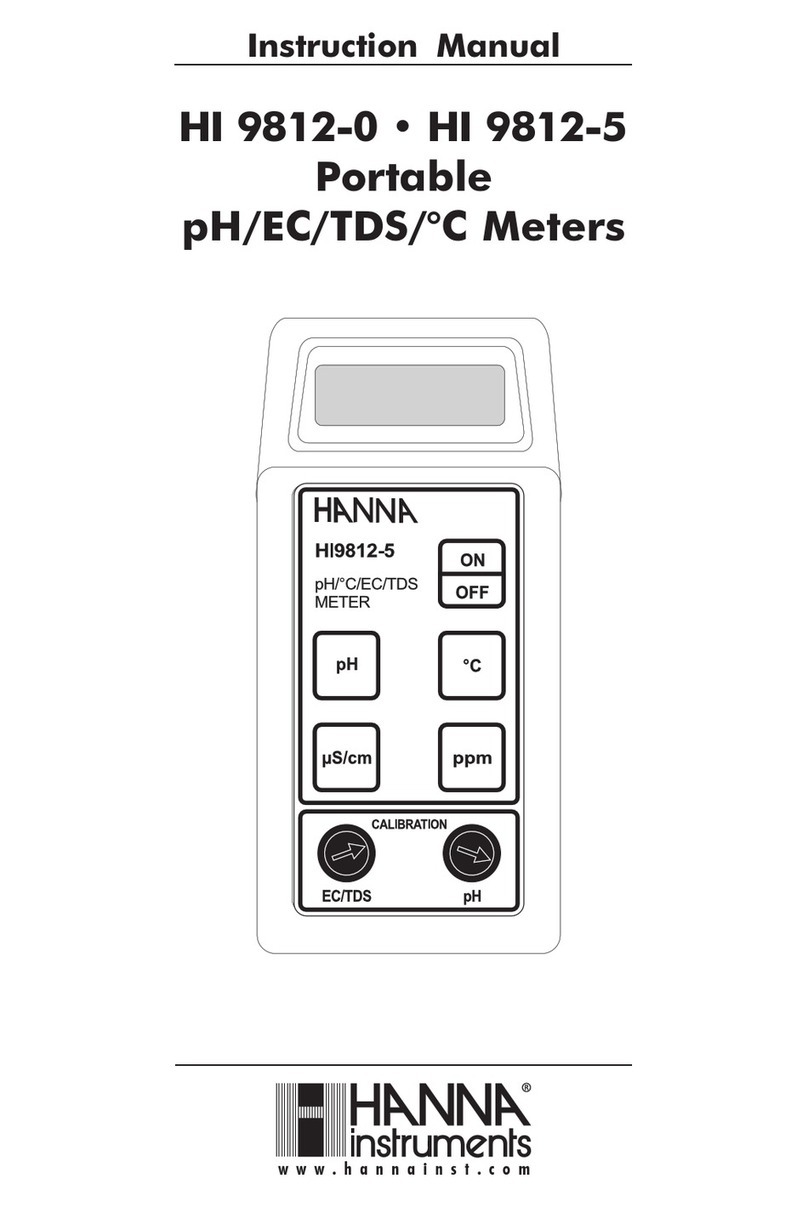
Hanna Instruments
Hanna Instruments HI 9812-0 instruction manual
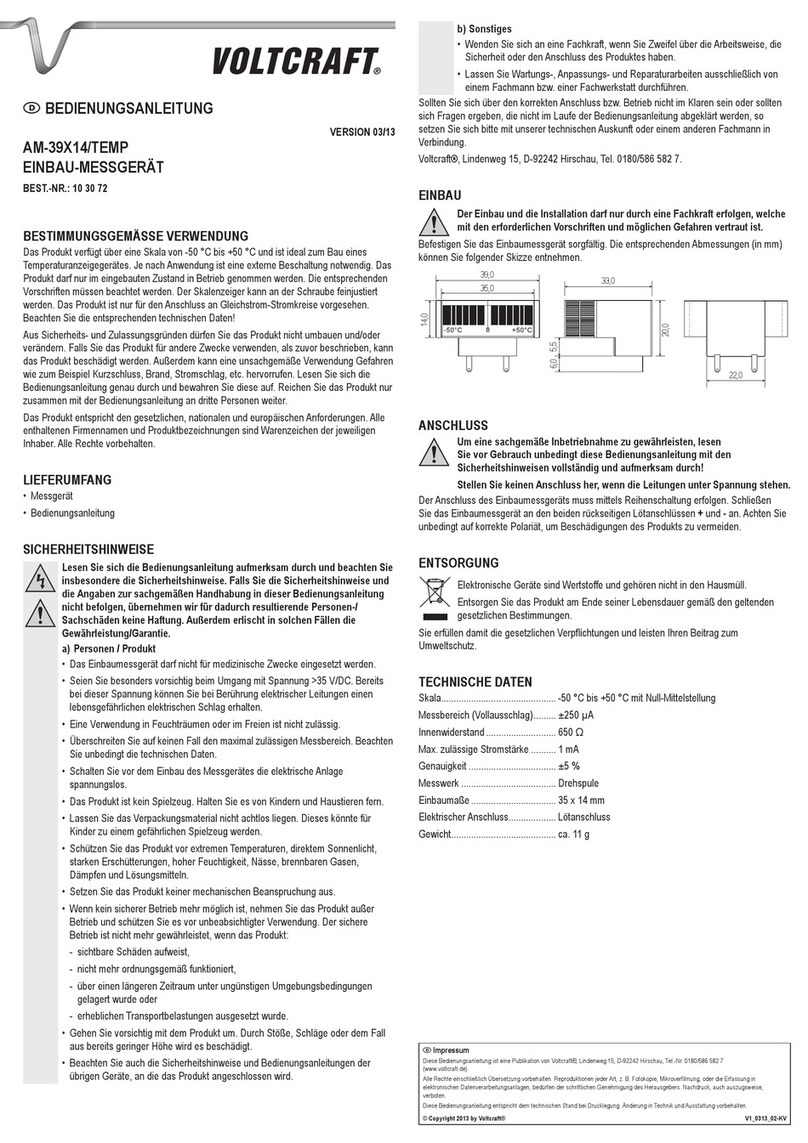
VOLTCRAFT
VOLTCRAFT AM-39X14/TEMP Operatoring Instructions
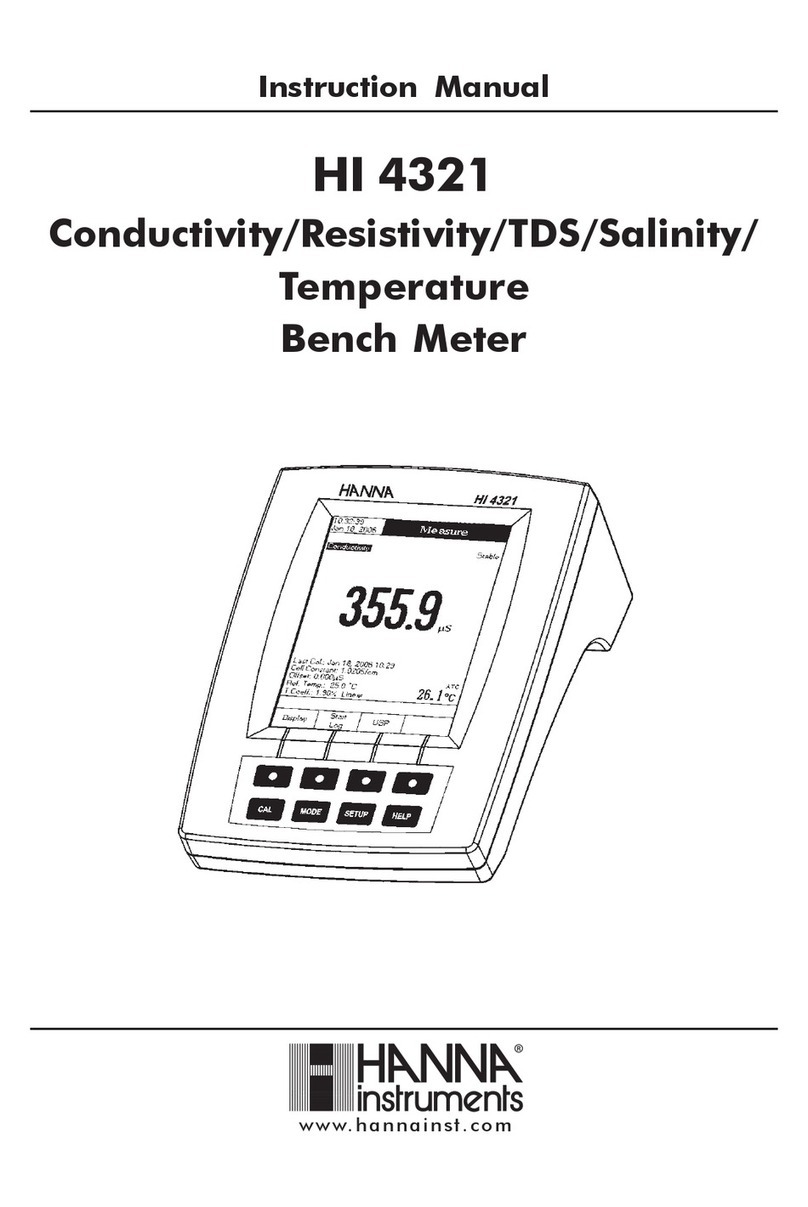
Hanna Instruments
Hanna Instruments HI 4321 instruction manual

Geokon
Geokon 4050 instruction manual
